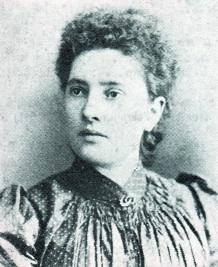From the files of the DIB…Mama Kevina, ‘flame in the bush’
Published in 18th–19th - Century History, 20th-century / Contemporary History, Issue 4 (Jul/Aug 2006), News, Volume 14 KEARNEY, Mother Kevin (1875–1957), missionary sister, was born on 28 April 1875 in Knockenrahan, Arklow, Co. Wicklow, the third and youngest daughter of Michael Kearney, farmer, and Teresa Kearney (née Grennell); she was baptised Mary Teresa. Her father died before her birth, and after her mother’s death in 1885 she was reared by her maternal grandmother in Curranstown, Arklow. She attended the local convent school in Arklow and in 1889 went to the Convent of Mercy at Rathdrum, where she trained as an assistant teacher. In 1893 she rejected a marriage proposal and moved to Essex to teach at a school run by the Sisters of Charity. After a dream of working in Africa, however, she entered the Franciscan Missionary Sisters of the Five Wounds at St Mary’s Abbey, Mill Hill, London, in 1895. Upon her profession on 21 April 1898 she took the name Sister Mary Kevin of the Sacred Passion, and in 1902 she was sent with five others to establish a mission alongside the Mill Hill Fathers in Nsambya, Uganda.
KEARNEY, Mother Kevin (1875–1957), missionary sister, was born on 28 April 1875 in Knockenrahan, Arklow, Co. Wicklow, the third and youngest daughter of Michael Kearney, farmer, and Teresa Kearney (née Grennell); she was baptised Mary Teresa. Her father died before her birth, and after her mother’s death in 1885 she was reared by her maternal grandmother in Curranstown, Arklow. She attended the local convent school in Arklow and in 1889 went to the Convent of Mercy at Rathdrum, where she trained as an assistant teacher. In 1893 she rejected a marriage proposal and moved to Essex to teach at a school run by the Sisters of Charity. After a dream of working in Africa, however, she entered the Franciscan Missionary Sisters of the Five Wounds at St Mary’s Abbey, Mill Hill, London, in 1895. Upon her profession on 21 April 1898 she took the name Sister Mary Kevin of the Sacred Passion, and in 1902 she was sent with five others to establish a mission alongside the Mill Hill Fathers in Nsambya, Uganda.
Upon their arrival on 15 January 1903, the sisters established a mission dispensary and school among the Baganda. By 1906 they had expanded to a second missionary station at Nagalama, some 23 miles away, of which Kearney became superior. Kearney returned to the Nsambya mission and assumed the leadership of both convents, taking the title Mother Kevin. In 1913, with the arrival of three more sisters, she established a third mission, this time in Kamuli, Busoga, east of Buganda. The missions expanded quickly and encompassed both medical and educational work. During World War I, the convent hospital at Nsambya was used to treat the Native Carrier Corps, the porters for European troops. As many of the sisters had been sent to nurse at a military hospital in Kisumu, Mother Kevin and one other nun ran the hospital on their own. Her war work was recognised when she was awarded an MBE in 1918.
Mother Kevin is credited with promoting higher education for Catholic African women, and with the help of Dr Evelyn Connolly, a lay missionary, she founded a nursing and midwifery school in Nsambya in 1924. Over the next 30 years she led the expansion of the mission throughout Uganda and Kenya, and founded numerous primary, secondary, teacher-training and nursing schools. Additionally, the sisters ran schools for the blind, orphanages, clinics, hospitals and two leprosaria. In May 1923 Mother Kevin oversaw the foundation of an ancillary African congregation, the Little Sisters of St Francis, when eight African girls approached her with the wish to enter the religious life. In 1927 the congregation moved from Nsambya to its own headquarters in Nkokonjeru, and by 1948 had over 200 members.
Despite the addition of the Little Sisters to aid the missionary effort, a chronic shortage of missionaries remained, and in 1928 Mother Kevin sought permission to establish a separate novitiate exclusively for the training of sisters for the African missions. She returned to England in September 1928 to pursue this goal and the novitiate was opened in 1929 at Holme Hall in Yorkshire. In 1935 the first Irish convent was founded at Mount Oliver, Dundalk, Co. Louth, and in 1937 this convent and Holme Hall, along with nineteen missions in Uganda and four in Kenya, became a separate African province of the Franciscan Missionary Sisters. Mother Kevin was elected as provincial superior and held this office until 1943. In June 1952 the province separated entirely from St Mary’s Abbey and became an independent congregation, the Franciscan Missionary Sisters for Africa, based at Mount Oliver with Mother Kevin as their superior-general. She continued in this office until she retired in 1955, aged 80.
Even in retirement she remained active, and in 1955 she travelled to the United States, where the sisters had a convent in Brighton, near Boston, Massachusetts (1953), to raise funds. That same year she received the CBE for her service to the people of Africa. She remained in the United States until her death in Brighton on 17 October 1957, aged 82, and her remains were flown to Ireland and interred at Mount Oliver. Upon hearing of her death, Ugandan Catholics rallied to have their ‘flame in the bush’ or Mama Kevina, both names by which she was popularly known, returned to Uganda, and on 3 December 1957 she received a second burial in the cemetery at Nkokonjeru, the mother-house of the Little Sisters of St Francis. The influence of her 54 years as a missionary is reflected in the use of the word ‘Kevina’ to mean a hospital or charitable institute in Uganda.
Deirdre Bryan is a former editorial assistant with the Dictionary of Irish Biography.
















